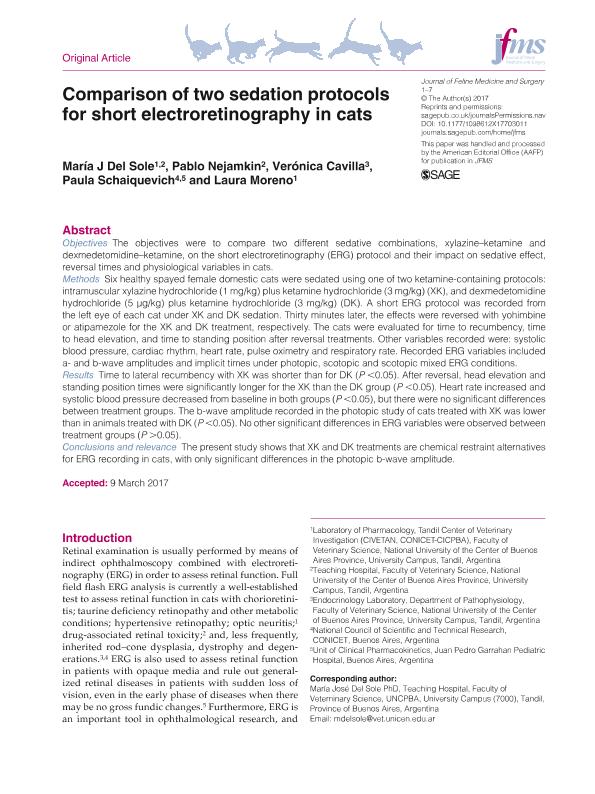Artículo
Comparison of two sedation protocols for short electroretinography in cats
del Sole, Maria Jose ; Nejamkin, Pablo
; Nejamkin, Pablo ; Cavilla, María Verónica
; Cavilla, María Verónica ; Schaiquevich, Paula Susana
; Schaiquevich, Paula Susana ; Moreno, Laura Susana
; Moreno, Laura Susana
 ; Nejamkin, Pablo
; Nejamkin, Pablo ; Cavilla, María Verónica
; Cavilla, María Verónica ; Schaiquevich, Paula Susana
; Schaiquevich, Paula Susana ; Moreno, Laura Susana
; Moreno, Laura Susana
Fecha de publicación:
02/2018
Editorial:
Elsevier
Revista:
Journal Of Feline Medicine And Surgery
ISSN:
1098-612X
e-ISSN:
1532-2750
Idioma:
Inglés
Tipo de recurso:
Artículo publicado
Clasificación temática:
Resumen
Objectives: The objectives were to compare two different sedative combinations, xylazine–ketamine and dexmedetomidine–ketamine, for the short electroretinography (ERG) protocol and their impact on sedative effect, reversal times and physiological variables in cats. Methods: Six healthy spayed female domestic cats were sedated using one of two ketamine-containing protocols: intramuscular xylazine hydrochloride (1 mg/kg) plus ketamine hydrochloride (3 mg/kg) (XK), and dexmedetomidine hydrochloride (5 µg/kg) plus ketamine hydrochloride (3 mg/kg) (DK). A short ERG protocol was recorded from the left eye of each cat under XK and DK sedation. Thirty minutes later, the effects were reversed with yohimbine or atipamezole for the XK and DK treatment, respectively. The cats were evaluated for time to recumbency, time to head elevation, and time to standing position after reversal treatments. Other variables recorded were: systolic blood pressure, cardiac rhythm, heart rate, pulse oximetry and respiratory rate. Recorded ERG variables included a- and b-wave amplitudes and implicit times under photopic, scotopic and scotopic mixed ERG conditions. Results: Time to lateral recumbency with XK was shorter than for DK (P <0.05). After reversal, head elevation and standing position times were significantly longer for the XK than the DK group (P <0.05). Heart rate increased and systolic blood pressure decreased from baseline in both groups (P <0.05), but there were no significant differences between treatment groups. The b-wave amplitude recorded in the photopic study of cats treated with XK was lower than in animals treated with DK (P <0.05). No other significant differences in ERG variables were observed between treatment groups (P >0.05). Conclusions and relevance: The present study shows that XK and DK treatments are chemical restraint alternatives for ERG recording in cats, with significant differences only in the photopic b-wave amplitude.
Palabras clave:
Feline
,
Sedative
,
Erg
Archivos asociados
Licencia
Identificadores
Colecciones
Articulos(CIVETAN)
Articulos de CENTRO DE INVESTIGACION VETERINARIA DE TANDIL
Articulos de CENTRO DE INVESTIGACION VETERINARIA DE TANDIL
Articulos(SEDE CENTRAL)
Articulos de SEDE CENTRAL
Articulos de SEDE CENTRAL
Citación
del Sole, Maria Jose; Nejamkin, Pablo; Cavilla, María Verónica; Schaiquevich, Paula Susana; Moreno, Laura Susana; Comparison of two sedation protocols for short electroretinography in cats; Elsevier; Journal Of Feline Medicine And Surgery; 20; 2; 2-2018; 172-178
Compartir
Altmétricas



